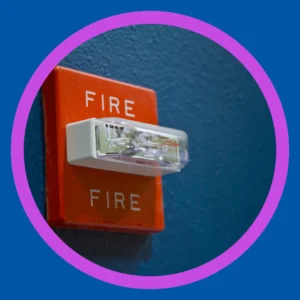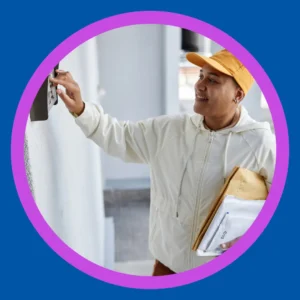How to Stay Safe with Hearing Loss
Living with hearing loss brings daily challenges, especially when it comes to personal safety. Staying safe with hearing loss starts at home. From missed alarms to communication barriers, hearing loss can increase risks. The good news? A few smart strategies can help you stay safe, confident, and connected—every single day.
Why Safety Is a Concern with Hearing Loss
Hearing loss reduces your ability to pick up important environmental cues. You may not hear a fire alarm, a knock at the door, or someone calling your name. But that doesn’t mean you can’t stay safe. You just need the right tools, plans, and support.
Learn about other challenges you may encounter with loss, such as the comorbidities of hearing loss.
Upgrade Your Home for Better Safety
Your home should be your safest place. If you have hearing loss, you may need to make a few key adjustments.

1. Install Specialized Alarms
Standard alarms rely on sound. For those with hearing loss, this isn’t enough.
Choose alarms that offer:
- Flashing lights
- Vibrating bed shakers
- Loud, low-pitched tones
Place alarms in your bedroom, kitchen, and hallways. Test them twice a year to ensure they work.
2. Add Carbon Monoxide Detectors with Visual Alerts
Carbon monoxide is invisible and odorless. Standard detectors won’t help if you can’t hear them.
Look for detectors that include:
- Flashing visual warnings
- Vibrating alert systems
- Combined smoke and CO options
Place one on every floor of your home.
3. Plan for Power Outages
Power outages can disrupt your alert systems.
Prepare by:
- Charging hearing aids regularly
- Keeping extra batteries on hand
- Using corded phones that don’t need power
- Alerting loved ones about your hearing loss
Create an emergency plan and share it with your family.
Be Prepared for Emergencies and Natural Disasters
Storms and emergencies often come without warning. Having a system in place is critical.
4. Use Weather Alert Systems
Standard weather alerts may be hard to hear.
Try:
- Weather radios with strobe lights
- Vibration-enabled pagers
- Smartphone apps with emergency alerts
Keep these devices nearby at all times.
5. Build a Safety Kit
Every home needs an emergency kit, especially for those with hearing loss.
Include:
- Flashlight and extra batteries
- Phone charger or power bank
- Written emergency contacts
- Backup hearing aids or parts
- Three-day supply of food and water
Keep your kit easy to access in case you need to leave quickly.
Smart Technology for Better Awareness
Modern technology can help fill the gaps caused by hearing loss.

6. Use Visual Doorbell and Motion Sensors
Missed visitors or deliveries can pose security risks.
Install devices like:
- Doorbells with flashing lights
- Motion detectors linked to your smartphone
- Doorbell cameras with video streaming
These tools ensure you always know who’s there.
7. Amplified and Captioned Phones
Phones can be tricky when hearing is limited.
Choose phones with:
- Adjustable sound levels
- Captioned text for calls
- Visual indicators for incoming calls
Keep your phone close at all times—especially in emergencies.
Create a Safer Driving Experience
Driving with hearing loss is possible—but it requires extra attention.
8. Driving Tips for Those with Hearing Loss
Stay alert on the road by limiting distractions and enhancing awareness.
Key tips:
- Always wear your hearing aids
- Keep music and conversation to a minimum
- Use wide-angle rearview mirrors
- Keep windows rolled up to reduce noise
Never guess what’s happening around you—use all your senses to stay safe.
Improve Communication with Visual Identifiers
In high-stress situations, like police stops or medical emergencies, miscommunication can happen fast.
9. Use Visual Aids to Signal Hearing Loss
Let others know you have hearing loss before misunderstandings arise.
Helpful tools include:
- Lanyards or pins that say “Hard of Hearing”
- Seatbelt covers with medical details
- Temporary car signs or visor cards
- Medical ID bracelets
These identifiers help first responders and bystanders communicate clearly and safely.
Stay Connected with Your Community
Isolation can make safety harder. Build a network that supports you.
10. Know Your Neighbors
Friendly neighbors can be lifesavers.
Ways to connect:
- Join a neighborhood watch
- Attend local events
- Share emergency contact info
They’ll know to check in on you during storms, power outages, or emergencies.
Explore our tips for communicating if you have hearing loss.
Keep Your Hearing Health in Check
Ongoing hearing care is essential for safety.
11. Get Regular Hearing Check-Ups
Hearing loss often changes over time.
Why check-ups matter:
- Ensure hearing aids are working
- Adjust settings as needed
- Discover new assistive technology
- Catch medical issues early
Stanford Hearing provides personalized hearing evaluations to help you stay ahead.
Understand your Medicare hearing aid benefits.
12. Wear Your Hearing Aids Daily
Hearing aids amplify important sounds that keep you safe.
They help with:
- Detecting alarms and sirens
- Following conversations in emergencies
- Navigating noisy public spaces
- Avoiding accidents at home and on the road
Wearing your devices regularly can improve your safety and quality of life.
Prepare for Safety at Work and in Public
Daily activities outside the home require extra planning too.
13. Safety Tips for Work and Public Places
Don’t let hearing loss limit your independence.
Make adjustments like:
- Using assistive listening devices
- Relying on visual alarms
- Informing colleagues or staff of your hearing needs
- Choosing quiet hours for errands or appointments
Proactive steps allow you to navigate public life with confidence.
Quick Recap: 10 Must-Follow Safety Tips
To stay safe with hearing loss, always:
- Install alarms with lights and vibration
- Use carbon monoxide detectors with visual alerts
- Prepare for power outages
- Set up emergency weather alerts
- Build a ready-to-go emergency kit
- Use visual doorbells and motion sensors
- Choose amplified or captioned phones
- Drive with hearing aids and low distractions
- Wear visual identifiers like pins or bracelets
- Stay connected with neighbors and hearing care providers
Each tip adds a new layer of safety and peace of mind.

Take Charge to Stay Safe With Hearing Loss
Staying safe with hearing loss is completely possible. You just need the right support, tools, and strategies. Stanford Hearing can help you every step of the way—from personalized care to the latest hearing solutions.
Contact Stanford Hearing today to schedule your hearing check-up and take charge of your safety.
